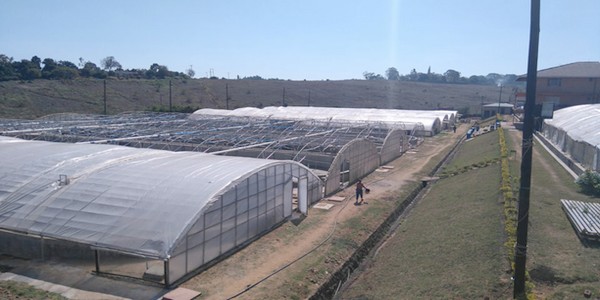Tilapia Biofloc Technology
Transition foam formation then it get brown. Tilapia and bioflocs.
Novel Approach To Tilapia Feeding
Tilapia Culture Second Edition 2020.

Tilapia biofloc technology. Transition is fast with tilapia longer with shrimp Add carbon if TAN is above 2 mgl Adding clay wheat bran etc. In fact leading scientists believe that harnessing the flow of microbes to fish represents the next revolution in food production see part 1 and part 2 of this article. The experiment was carried out for 46 days and consisted of two cycles of.
Fish and shrimp are grown in an intensive way minimum of 300 g of biomass per square meter 7 with zero or minimum water exchange. A number of studies showed the numerous benefits of BFT to freshwater tilapia aquaculture. Development of biofloc system It may take a few weeks depends on the biomass.
The international research organization WorldFish Center recently estimated that by 2030 the worlds population will require 232 million metric tons MMT of seafood approximately 62 MMT more than we are expected to produce. Mozambique tilapia Oreochromis mossambicus is a good candidate species for production in biofloc systems. Biochar serves as an alternative carbon source for biofloc technology BFT and maintains good water quality and biofloc quality for tilapia Oreochromis niloticus culture.
Despite indicative growth and feed cost savings demonstrated in experimental tilapia BFT. Up to 10 cash back Abstract. Biochar influenced the activities of the bacterial community in the biofloc systems.
Tilapia Production Using BioFloc Technology BFT Yoram Avnimelech. Considered as the new blue revolution in aquaculture Biofloc technology is currently the most profitable technique being used by the fish farmers. Of Civil Environmental EngTechnion Israel Inst.
The aim of the present study was to evaluate the use of the technology we have named for the first time as FLOCponics biofloc hydroponic FP and conventional aquaponics AP systems in producing Nile tilapia Oreochromis niloticus juveniles and lettuce Lactuca sativa. Niloticus in Biofloc technology using 17-α-methyltestosterone in the diet Author links open overlay panel Rodrigo Zhouri Costa e Silva a Érika Ramos de Alvarenga a Sylvia Velloso da Matta a Gabriel Francisco de Oliveira Alves a Ludson Guimarães Manduca a Marcos Antônio da Silva a Thomás. Tilapia are ideally adapted to biofloc systems.
The sustainable characteristics of biofloc-based culture are. The filter-feeding herbivores adapt to the harvest of bioflocs suspended in the water and the strong stable fish grow and flourish in dense systems. Biofloc technology BFT promises to revolutionize tilapia and shrimp aquaculture industries globally.
Harvesting tilapia from cages in Lake Kariba Zimbabwe. Experience raising tilapia in biofloc technology BFT where aerial feeding rates are at least four to five orders of magnitude greater than in shrimp BFT systems is limited. Areas that are particularly limited are knowledge systems centered on BFT engineering economics tilapia feeding systems and bioenergetics cost factors and the economics of this new technology relative to.
Biofloc technology BFT has been called an environmentally friendly aquaculture approach. Masculinization protocol for Nile tilapia O. Fish tilapia Mozambique 107 g were stocked in 1 m3 tanks filled with water from a limited exchange intensive tilapia producing pond bio-floc technology BFT system.
Biofloc Technology is the new blue revolution in aquaculture which ensures sustainable production by breeding fish using minimum resources like feed water and land and thus preserving the nature. Production of tilapia for home or local consumption and for export has been raised tremendously in the last few decades. In the authors experience tilapia biomass.
An essential feature of biofloc tilapia production systems especially as compared to shrimp systems is the very high biomass. This technology provides a sustainable tool to simultaneously add. Biofloc technology BT is defined as the use of aggregates of bacteria algae or protozoa held together in a matrix along with particulate organic matter for the purpose of improving water quality waste treatment and disease prevention in intensive aquaculture systems.
Serves as seeding for biofloc formation. GIFT Tilapia Fish Farming using Biofloc Technology. Biofloc technology BFT is as an environmentally friendly aquaculture technique based on in situ microorganism production.
Tilapia Production Using Biofloc Technology Global Aquaculture Advocate
Optimizing Tilapia Biofloc Technology Systems Part 3 Engormix
Biofloc Technology And Its Application In Freshwater Tilapia Culture Youtube
Optimizing Tilapia Biofloc Technology Systems Part 2 Global Aquaculture Advocate
Indian State Launches Biofloc Tech To Raise Fish Production
Optimizing Tilapia Biofloc Technology Systems Part 1 Engormix
Ten Easy Steps Towards Biofloc Production Of Shrimp Or Tilapia The Fish Site
Optimizing Tilapia Biofloc Technology Systems Part 1 Engormix
Optimizing Tilapia Biofloc Technology Systems Part 2
How To Start Biofloc Farming Biofloc Fish Farming Biofloc Farming Guide What Is Biofloc Farming Youtube
Optimizing Tilapia Biofloc Technology Systems Part 2 Global Aquaculture Advocate
Large Scale Biofloc Tank Culture Of Tilapia In Malawi A Technical Success Story Engormix
India Introduces New Policy To Boost Biofloc Technology The Fish Site
Pdf Biofloc Technology Bft And Its Application Towards Improved Production In Freshwater Tilapia Culture Semantic Scholar
Optimizing Tilapia Biofloc Technology Systems Part 2 Global Aquaculture Advocate
Optimizing Tilapia Biofloc Technology Systems Part 3 Global Aquaculture Advocate
Ten Easy Steps Towards Biofloc Production Of Shrimp Or Tilapia The Fish Site




Post a Comment for "Tilapia Biofloc Technology"